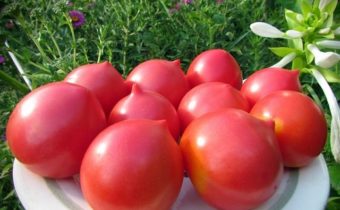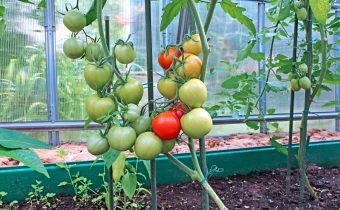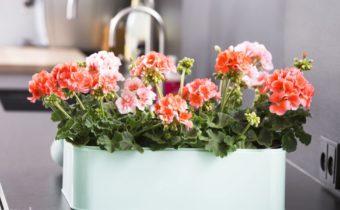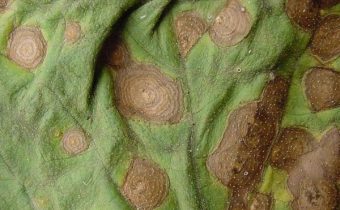Hydroponic Tomatoes
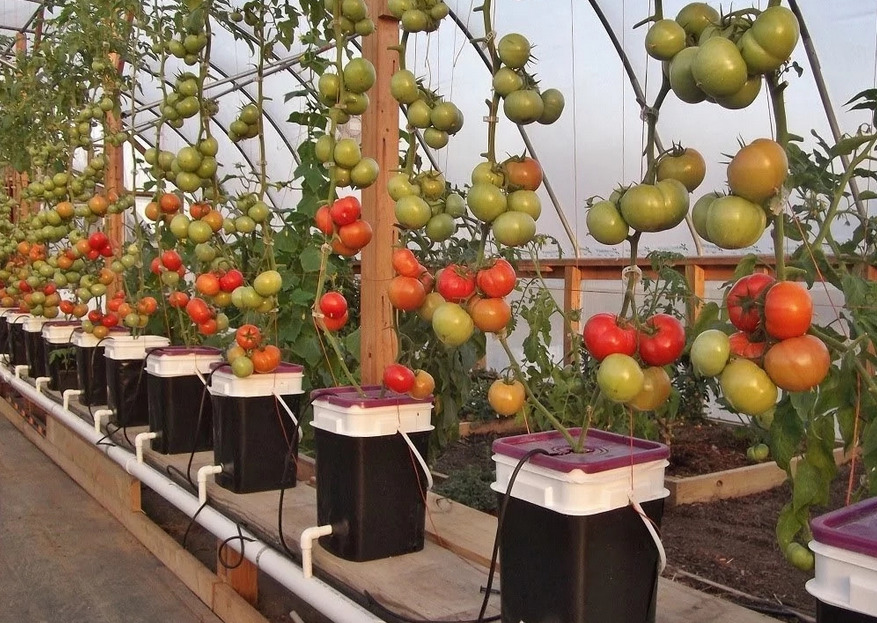
Tomatoes are the most popular crop in most gardeners. Many of them have tried a method of cultivating tomatoes on an artificial medium without soil, which allows regulating the conditions for growing plants.
Hydroponic work
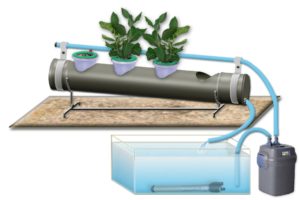
The hydroponic method is a substitute for the usual cultivation of plants in the soil. This technology is applicable in cases where it is not possible to plant vegetables or greens directly in the soil mixture. The method is quite expensive. However, it quickly pays for itself when growing plants in regions with adverse climatic conditions.
When using the method, the cultures dispense with the soil, are in an environment that serves as a support for the root system, receiving all the nutrients from a special solution. For each culture, the solution is selected individually depending on the needs. From it, plants are fed with potassium, nitrogen, phosphorus, and other essential trace elements.
Plants are placed in a substrate that is regularly irrigated with water, because in addition to minerals and vitamins, the root system needs oxygen. Indeed, under the influence of light and heat, photosynthesis occurs in chlorophyll leaf grains. As a result of this process, the air around the plants is enriched with oxygen and depleted of carbon dioxide.
Despite the fact that the hydroponic technique is an innovative technology, the ancient Babylonians used it several thousand years ago to create the famous Hanging Gardens.
Advantages of the hydroponic method
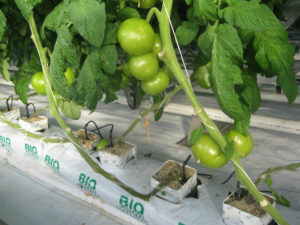
The use of hydroponics accelerates the process of fruit ripening, since it is easier to provide plants with temperature and humidity levels when cultivated indoors. It has advantages over the standard method of growing:
- vegetables and berries grown by the hydroponic method are fully micro and macro elements, which contributes to their accelerated development. Plants have abundant flowering and increased yield;
- you can not remember the existing threat of drying out or waterlogging of the soil;
- in the artificial environment there are no pathogenic fungi and insect pests, so there is no need to use chemical agents;
- when transplanting a plant, it does not get injured root system, since they do not need to be freed from a clod of earth. It is enough to transfer the culture to another vessel, adding a hydroponic solution to it;
- the root system of plants in abundance receives moisture and oxygen;
- no negative odors when growing and dirt;
- with groundless cultivation in the environment do not accumulate radionuclides and nitrates, and the fruits are environmentally friendly;
- cultivating plants on hydroponic systems is an aesthetically beautiful green corner in every room.
Disadvantages of the hydroponic method
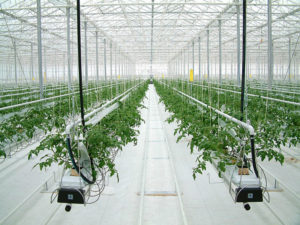
The disadvantages of groundless cultivation of plants include:
- considerable costs for the purchase and installation of structures, as well as hydroponic solution;
- constant control over the composition of the working solution;
- the difficulty in growing plants with a long growing season;
- impossibility of cultivation of tuberous plants.
The substrate itself does not provide any nutrients to the root system. It serves only as a support for plants. The feed for active growth is the hydroponic solution itself.
Installation Options
Depending on the environment in which the plants will be located, the installations share:
- technology agregatoniku, in which tomatoes are grown in dense inorganic elements: volcanic glass-perlite, expanded clay gravel and rubble, other crushed inorganic granular materials. Using this technology, plants are watered with a special nutrient solution, using an artificial medium for 3-5 years;
- Chemoponics technology, in which tomatoes are cultivated in an organic environment like: riding neutralized peatland, peat moss, wood chips. As well as rice milling waste and husk from sunflower seeds. Recharge with minerals using this technology occurs superficially, without requiring special equipment for irrigation;
- Ionitoponics technology, in which high-molecular-weight synthetic compounds with macroporous structure are used as a medium for cultivating tomatoes. Substances are able to retain and retain nutrients in themselves, gradually giving them to the root system. With this technology, plants are watered only with plain water without the addition of trace elements;
- technology aeroponiku, in which the root system of tomatoes hang in the air, and irrigation with water and nutrients takes place by spraying. To keep the roots dry, an automatic spraying is carried out every few seconds. Using technology, it takes less space, because the aeroponic installation can be equipped in a vertical position;
- water cultivation technology, in which plants are rooted in a high layer of sterile substrate on a low concentration hydroponic nutrient solution. For the medium, a porous material concrete, lactone or basalt sand is used, under which a vessel with water and nutrients is placed in a hydroponic tank.
The method of cultivation in artificial environments is not applicable for every plant. Hydroponic method is not used for cultivation: potatoes, carrots, mushrooms, beets, celery root.
Necessary materials
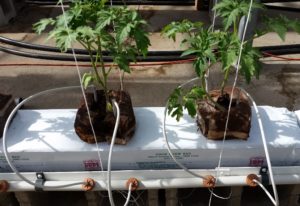
With proper design and installation of hydroponics, the structures allow the use of any free space in the room efficiently, growing a large number of plants even on the windowsill or in the wardrobe. This will require:
- plastic or glass opaque capacity of 3-20 liters for the content of water and nutrients;
- containers for the substrate;
- peristaltic or drainage hose pump for filling water into the system;
- filler substrate;
- sanding paper for processing edges;
- construction knife
Irrigation systems for hydroponic system
In addition to creating a hydroponic construction for the cultivation of tomatoes, care should be taken to organize quality drip or sprinkler irrigation. By equipping the system with automatic irrigation, you can also simplify the care of plants.
Point irrigation system
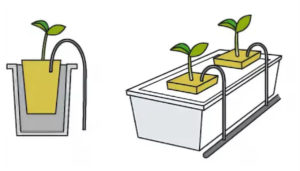
If you wish, you can make your own hydroponic system without large financial investments by integrating drip irrigation into it. Such a system is well suited for beginners, and the environment inside the structure will protect the root system from sudden changes in temperature and user errors. For this you will need:
- rectangular plastic troughs;
- mineral wool or coconut substrate in briquettes;
- mini pump;
- low-cost irrigation main with secondary plastic spaghetti pipes.
Periodic Irrigation System
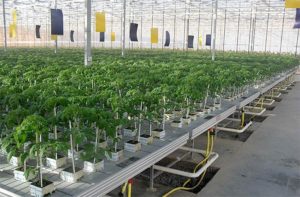
When using this irrigation system, the medium is completely filled with hydroponic solution with trace elements, then all the liquid is drained. The system is a plastic seedling trough mounted on a bulk plastic container with water. For mobility, a tank with a solution is placed at the bottom. The periodic flooding mechanism starts operation thanks to the pump, which is located under the tank.
When you turn on the hydraulic device, the nutrient solution slowly fills the seedling trough. In the process of this action, the accumulated air is displaced, oxygen is created, the formed carbon dioxide is squeezed out.
When you turn off the hydraulics, the nutrient solution begins to independently leak into the container with water through the same openings through which it rose. By raising and lowering the height of the water, the system provides plants with access to oxygen, without which the normal process of photosynthesis will not occur. For this you will need:
- well drained substrate;
- mini pump;
- capacity tank from opaque plastic of 8-20 l;
- rectangular seedling trough.
The big drawbacks of the irrigation system of point irrigation and periodic flooding is dependence on electricity. After all, if there is no power supply to the pump or pump even for a few hours, the plants will become sick and may die.
Irrigation system for passive hydroponics
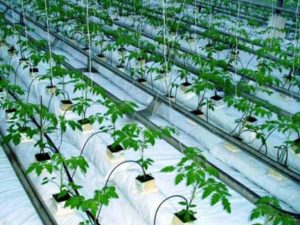
The use allows maintaining soil moisture in pots due to synthetic moisture-consuming felt. The unique irrigation device provides continuous moistening up to twenty days, having a supply of water up to 20 l.
The principle of the passive irrigation device is to place the plants in a tank filled with an organic substrate. The container with the plant is separated by a barrier with a lower part in which there is water. A moisture-absorbing synthetic cord is placed at the top of the container, sagging through the water compartment. Due to the physical phenomenon that can change the level of liquid in narrow capillaries, water rises along the cord and supplies the root system with moisture and nutrients. To apply passive irrigation, you will need:
- containers for plants;
- synthetic moisture-absorbing thread;
- priming.
Cultivation technology
When growing tomatoes, nutrient solution is a key element, as the plants will be able to receive water only from this mixture. And to grow tomatoes hydroponically in greenhouses and indoors, you should follow some rules.
Growing seedlings
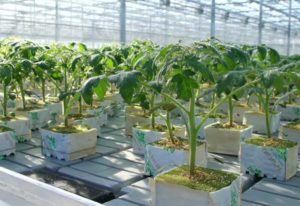
Young seedlings at the very beginning of its development needs to be protected and protected from diseases. She needs to pay close attention, because the future harvest will depend on the health of small seedlings. At the beginning of the cultivation of tomatoes on artificial media, seedlings grow much faster, and the seeds do not need to germinate and disinfect.
- When sowing seeds on seedlings, take a regular sponge for washing dishes, soak it for half an hour in water with the addition of “Epin” or “Zircon”.
- Sponge cut into strips, spread out the seeds at a distance of 2 cm by 2 cm.
- Place the wet material with seeds in the brightest place, soaking it with water with the addition of a growth stimulator three times a day.
- For good growth of young seedlings to provide the plants with an air temperature of + 25- + 28 degrees and a light day for at least 13 hours.
- The maximum term for growing seedlings in spongy material is 20 days. After that, sponge gently cut into pieces so that in each piece there was one plant.
- Instead of standard soil mixture, for transplanting young seedlings to prepare an artificial environment. This may be: concrete, lactone, basalt sand or high-moor peat with coconut chips.
- To the substrate at the rate of 6 kg of substance add: 2 cups of ash, 1 tablespoon of nitrate, 1 tablespoon of potassium, 1 tablespoon of superphosphate, 0.5 g of manganese potassium.
- Stir the substrate, add water so that the finished medium has the consistency of liquid porridge. Plant young tomatoes in the substrate with foam rubber.
It is possible to add mineral fertilizers to the nutrient solution and feed it to the root system only after the seedlings are fully established.
Adult plants
Growing tomatoes using the hydroponic method, you will need: materials depending on the type of system, pots for placing tomatoes of at least 4 liters volume vessels-tanks for the content of the nutrient solution.
- Prepare the prepared pots with boiling water, fill with the substrate, plant the tomatoes using one of the hydroponic methods.
- Water the planted plants.
- Providing indoor or greenhouse air temperature +25 - +28 degrees and light day 14-15 hours, carry out all necessary agrotechnical measures.
- Provide a nutrient solution consisting of: 100 mg of nitrogen, 80 mg of phosphorus, 150 mg of potassium, 190 mg of calcium, 30 mg of magnesium per 1000 ml of water.
- During the entire cultivation season, remove the stepsons in a timely manner, loosen the substrate after each feeding of the nutrient solution.
Recommended varieties
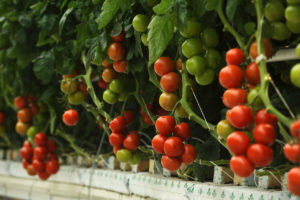
When growing tomatoes in a hydroponic way, the choice of variety or hybrid plays a big role. The most suitable are ultra short ripened. hybridsthat are resistant to short daylight hours:
- Asvon F1;
- Supernova F1;
- Katyusha;
- Newcomer;
- Lyon F1;
- Ballad;
- Yana;
- First-grader;
- Rio Grande;
- Svitnes F1;
- Jug;
- Florida F1.
Cultivation of tomatoes by the hydroponic method is a great opportunity to get a harvest all year round. And it will be possible to enjoy your own juicy fruits even in winter, despite the minus temperature outside the window.


